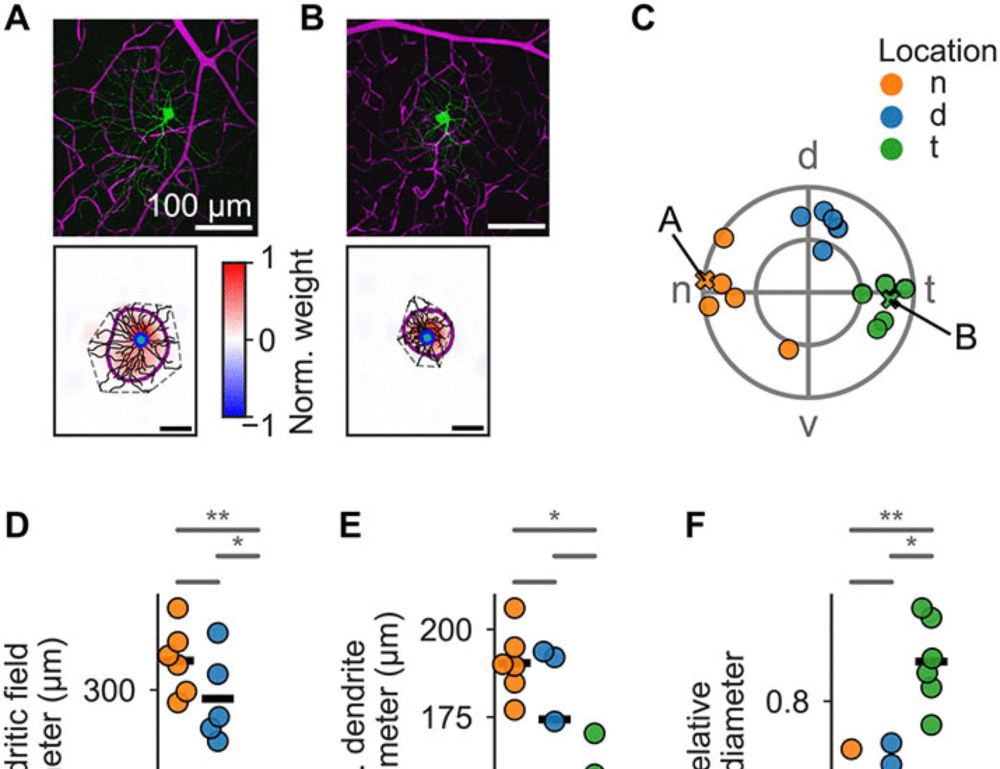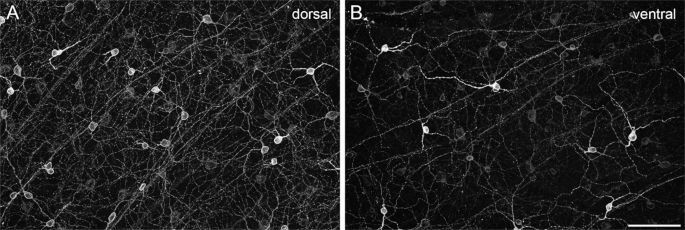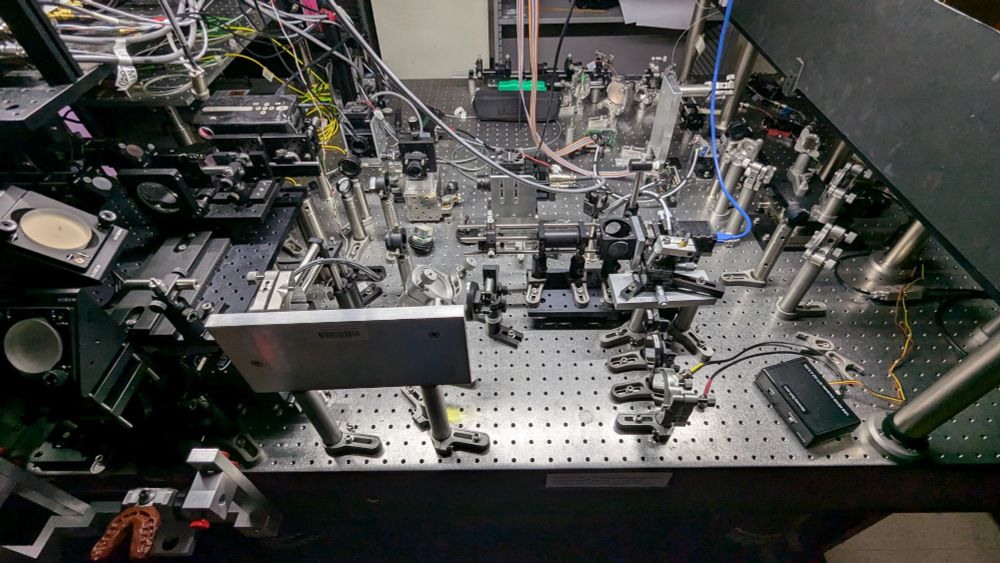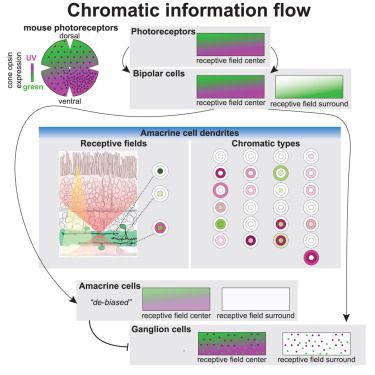
Christian Puller
@christianpuller.bsky.social
Neuroscientist at Max Planck Institute for Neurobiology of Behavior. Interested in vision, retina research, and gravel/road cycling.
Pinned

The first interneuron of the mouse visual system is tailored to the natural environment through morphology and electrical coupling
Biological sciences; Neuroscience; Cellular neuroscience; Sensory neuroscience
www.cell.com
Interested in interneurons? Retina? Electrical coupling? Check out my first senior author paper which just went online www.cell.com/iscience/ful...
(Find a short summary a little bit further down my timeline)
(Find a short summary a little bit further down my timeline)
Awesome work by @gregdfield.bsky.social et al. www.biorxiv.org/content/10.1... Projection Targeting with Phototagging to Study the Structure and Function of Retinal Ganglion Cells | bioRxiv
Projection Targeting with Phototagging to Study the Structure and Function of Retinal Ganglion Cells
Visual information from the retina is sent to diverse targets throughout the brain by different retinal ganglion cells (RGCs). Much of our knowledge about the different RGC types and how they are routed to these brain targets is based on mice, largely due to the extensive library of genetically modified mouse lines. To alleviate the need for using genetically modified animal models for studying retinal projections, we developed a high-throughput approach called projection targeting with phototagging that combines retrograde viral labeling, optogenetic identification, functional characterization using multi-electrode arrays, and morphological analysis. This method enables the simultaneous investigation of projections, physiology, and structure-function relationships across dozens to hundreds of cells in a single experiment. We validated this method in rats by targeting RGCs projecting to the superior colliculus, revealing multiple functionally defined cell types that align with prior studies in mice. By integrating established techniques into a scalable workflow, this framework enables comparative investigations of visual circuits across species, expanding beyond genetically tractable models. Motivation Visual information from the retina is distributed to diverse targets throughout the brain. Much of our knowledge about how visual information is processed and routed to these brain targets is based on mice because of the large library of genetically modified mouse lines. For most other species, such libraries are not available. Therefore, we were motivated to develop an approach for characterizing diverse retinal projections into the brain that can be applied to other species. We aimed to achieve projection targeting with retrograde viral vectors, followed by identification of circuit-specific retinal ganglion cells (RGCs) with optogenetics, functional characterization with multi-electrode array (MEA) recordings, and morphological description with in situ and confocal microscopy. The resulting high-throughput approach permits functional and morphological investigation of dozens to hundreds of cells in individual experiments. By replacing the need for genetically modified animals with a suite of standard techniques, this approach should improve cross-species comparisons of the initial stages of visual processing. Summary Understanding the structure-function relationships across neurons is challenging, particularly when circuits are composed of dozens of distinct cell types. We refined an approach, called projection targeting with phototagging, that allows simultaneous elucidation of the projections, morphology, and visual response properties of diverse RGC types in the mammalian retina. The approach combines retrograde virally mediated phototagging of RGCs, microscopy, and large-scale MEA measurements. Importantly, the approach does not rely on transgenic animals and thus is generalizable across species. We validated this approach in rats by targeting retinal projections to the superior colliculus (SC). We showed that multiple RGC types project to the SC and that these results in rats align well with prior findings from transgenic mouse studies. ![Figure][1]</img> Highlights ### Competing Interest Statement K.R. Is a coauthor on a patent for AAV2retro (Application No. 62/350,361 filed June 15, 2016, and U.S. Application No. 62/404,585 filed October 5, 2016). * AAV : adeno-associated virus cMRF : central mesencephalic reticular formation CRF : contrast response functions DpG : deep gray layer of the superior colliculus DpWh : deep white layer of the superior colliculus EI : electrical image GCL : ganglion cell layer IC : inferior colliculus INL : inner nuclear layer InG : intermediate gray layer of the superior colliculus IPL : Inner Plexiform Layer InWh : intermediate white layer of the superior colliculus ISI : inter-spike interval distribution MEA : multi-electrode array MGN : medial geniculate nucleus of the thalamus OT : nucleus of the optic tract Op : optic nerve layer of the superior colliculus OSI : orientation-selective index PAG : periaqueductal gray PC : posterior commissure POD : post-operative day PT : pretectum ReaChR : red-shifted channelrhodopsin RF : receptive field RGC : retinal ganglion cell SRF : spatial receptive field SuG : superficial gray layer of the superior colliculus TRF : temporal receptive field Zo : zonal layer of the superior colliculus Duke Institute for Brain Sciences (DIBS) Incubator Award NIH R01 EY034004 K99 EY032119 NIH P30 EY005722 Core Grant for Vision Research at Duke University NIH P30 EY000331 for Vision Research and an Unrestricted Grant from Research to Prevent Blindness at UCLA [1]: pending:yes
www.biorxiv.org
July 8, 2025 at 6:47 AM
Awesome work by @gregdfield.bsky.social et al. www.biorxiv.org/content/10.1... Projection Targeting with Phototagging to Study the Structure and Function of Retinal Ganglion Cells | bioRxiv
Reposted by Christian Puller
Exciting news:
⭐I'm thrilled to receive a grant from the Brain Research Foundation! tinyurl.com/2p9ku4sd
⭐"Atypical retinal ganglion cell function in a mouse model of Fragile X syndrome" was published! tinyurl.com/htk3ekce
⭐my review on retinal receptive fields was published! tinyurl.com/48b9xbs2
⭐I'm thrilled to receive a grant from the Brain Research Foundation! tinyurl.com/2p9ku4sd
⭐"Atypical retinal ganglion cell function in a mouse model of Fragile X syndrome" was published! tinyurl.com/htk3ekce
⭐my review on retinal receptive fields was published! tinyurl.com/48b9xbs2

a picture of a woman with the words this is exciting below her
ALT: a picture of a woman with the words this is exciting below her
media.tenor.com
July 2, 2025 at 2:06 AM
Exciting news:
⭐I'm thrilled to receive a grant from the Brain Research Foundation! tinyurl.com/2p9ku4sd
⭐"Atypical retinal ganglion cell function in a mouse model of Fragile X syndrome" was published! tinyurl.com/htk3ekce
⭐my review on retinal receptive fields was published! tinyurl.com/48b9xbs2
⭐I'm thrilled to receive a grant from the Brain Research Foundation! tinyurl.com/2p9ku4sd
⭐"Atypical retinal ganglion cell function in a mouse model of Fragile X syndrome" was published! tinyurl.com/htk3ekce
⭐my review on retinal receptive fields was published! tinyurl.com/48b9xbs2
Reposted by Christian Puller
This is a fantastic up-to-date summary of modern questions in retinal circuits, clearly presented and with great figures!. Required reading for anyone interested in the amazing computational capabilities of neural circuits. Congrats and a big thank-you to the authors.
It was great fun to write this review together with @katrinfranke.bsky.social and @serenariccitelli.bsky.social on behavior-specific computations in the moose retina.
65 years after Lettvin’s bug detector neurons in the frog retina, we revisit how the retina drives behavior—from reflexes to prey capture to brain-state modulation
New review with @annaintegrated.bsky.social & @serenariccitelli.bsky.social in Annual Review of Vision Science 👇
tinyurl.com/ymp3vs4d
New review with @annaintegrated.bsky.social & @serenariccitelli.bsky.social in Annual Review of Vision Science 👇
tinyurl.com/ymp3vs4d
May 16, 2025 at 4:17 AM
This is a fantastic up-to-date summary of modern questions in retinal circuits, clearly presented and with great figures!. Required reading for anyone interested in the amazing computational capabilities of neural circuits. Congrats and a big thank-you to the authors.
Reposted by Christian Puller
65 years after Lettvin’s bug detector neurons in the frog retina, we revisit how the retina drives behavior—from reflexes to prey capture to brain-state modulation
New review with @annaintegrated.bsky.social & @serenariccitelli.bsky.social in Annual Review of Vision Science 👇
tinyurl.com/ymp3vs4d
New review with @annaintegrated.bsky.social & @serenariccitelli.bsky.social in Annual Review of Vision Science 👇
tinyurl.com/ymp3vs4d

May 15, 2025 at 5:10 PM
65 years after Lettvin’s bug detector neurons in the frog retina, we revisit how the retina drives behavior—from reflexes to prey capture to brain-state modulation
New review with @annaintegrated.bsky.social & @serenariccitelli.bsky.social in Annual Review of Vision Science 👇
tinyurl.com/ymp3vs4d
New review with @annaintegrated.bsky.social & @serenariccitelli.bsky.social in Annual Review of Vision Science 👇
tinyurl.com/ymp3vs4d
Reposted by Christian Puller
Happy Birthday Gerald Westheimer. 101 years on May 13 and still publishing papers! #livinglegend of #visionscience. @ucberkeleyofficial.bsky.social

May 13, 2025 at 3:51 AM
Happy Birthday Gerald Westheimer. 101 years on May 13 and still publishing papers! #livinglegend of #visionscience. @ucberkeleyofficial.bsky.social
Putting this on top of my reading list: Task-specific regional circuit adaptations in distinct mouse retinal ganglion cells | Science Advances www.science.org/doi/10.1126/...

Task-specific regional circuit adaptations in distinct mouse retinal ganglion cells
The mouse retina shows regional adaptations in signal processing that enhance their ability to detect prey during hunting.
www.science.org
May 13, 2025 at 11:58 AM
Putting this on top of my reading list: Task-specific regional circuit adaptations in distinct mouse retinal ganglion cells | Science Advances www.science.org/doi/10.1126/...
Reposted by Christian Puller
With all the chaos and destruction of academic research going on in the US right now, it feels a little weird to post this. But....
New preprint from the lab is now live: www.biorxiv.org/content/10.1...
1/n
New preprint from the lab is now live: www.biorxiv.org/content/10.1...
1/n

PTEN regulates starburst amacrine cell dendrite morphology during development
Neurons are subject to extensive developmental regulation to ensure precise subtype-specific morphologies that are intimately tied to their function. Starburst amacrine cells (SACs) in the mammalian r...
www.biorxiv.org
May 9, 2025 at 5:35 PM
With all the chaos and destruction of academic research going on in the US right now, it feels a little weird to post this. But....
New preprint from the lab is now live: www.biorxiv.org/content/10.1...
1/n
New preprint from the lab is now live: www.biorxiv.org/content/10.1...
1/n
Reposted by Christian Puller
I am delighted to present to all my latest research paper titled " #AAV-mediated transduction of #songbird #retina" which has been published in the journal " #Frontiers in #Physiology", in its special issue "Rising Stars in Avian Physiology: 2024".
#birds #AAV
www.frontiersin.org/journals/phy...
#birds #AAV
www.frontiersin.org/journals/phy...

Frontiers | AAV-mediated transduction of songbird retina
www.frontiersin.org
March 19, 2025 at 11:40 AM
I am delighted to present to all my latest research paper titled " #AAV-mediated transduction of #songbird #retina" which has been published in the journal " #Frontiers in #Physiology", in its special issue "Rising Stars in Avian Physiology: 2024".
#birds #AAV
www.frontiersin.org/journals/phy...
#birds #AAV
www.frontiersin.org/journals/phy...
1/ There it is! 😊 Published today in Scientific Reports: www.nature.com/articles/s41...

Spatial distribution and functional integration of displaced retinal ganglion cells - Scientific Reports
Scientific Reports - Spatial distribution and functional integration of displaced retinal ganglion cells
www.nature.com
February 28, 2025 at 1:34 PM
1/ There it is! 😊 Published today in Scientific Reports: www.nature.com/articles/s41...
Reposted by Christian Puller
Apply for your participation in the Systems Vision Science Summer School and Symposium 2025: summerschool.lizhaoping.org/application/ Application deadline is March 31, 2025. Experimental vision researchers, vision theorists, engineers and computer scientists should not miss this unique event!
January 9, 2025 at 12:30 PM
Apply for your participation in the Systems Vision Science Summer School and Symposium 2025: summerschool.lizhaoping.org/application/ Application deadline is March 31, 2025. Experimental vision researchers, vision theorists, engineers and computer scientists should not miss this unique event!
Reposted by Christian Puller
More complete announcement to come, but heads-up about a new summer course on Visual Neuroscience at the MBL, Woods Hole! Hands-on training in imaging, EM, bioinformatics, electrophysiology, visual behavior. From octopus to mouse, from retina to brain! Aug.
1-16, 2025 www.mbl.edu/education/ad...
1-16, 2025 www.mbl.edu/education/ad...
Visual Neuroscience | Marine Biological Laboratory
Experience hands-on training in modern visual neuroscience techniques in the new Visual Neuroscience course. Join us for a life-changing experience learning the visual system - and return home with te...
www.mbl.edu
December 5, 2024 at 6:42 PM
More complete announcement to come, but heads-up about a new summer course on Visual Neuroscience at the MBL, Woods Hole! Hands-on training in imaging, EM, bioinformatics, electrophysiology, visual behavior. From octopus to mouse, from retina to brain! Aug.
1-16, 2025 www.mbl.edu/education/ad...
1-16, 2025 www.mbl.edu/education/ad...
Reposted by Christian Puller
Volume 1 of the "Early Vision" pack is now full-up so I started populating Volume II go.bsky.app/5z7mP26
Addition requests, as before, please fill this google form:
forms.gle/4ZdNjejitMQu...
Addition requests, as before, please fill this google form:
forms.gle/4ZdNjejitMQu...
December 11, 2024 at 2:30 PM
Volume 1 of the "Early Vision" pack is now full-up so I started populating Volume II go.bsky.app/5z7mP26
Addition requests, as before, please fill this google form:
forms.gle/4ZdNjejitMQu...
Addition requests, as before, please fill this google form:
forms.gle/4ZdNjejitMQu...
Reposted by Christian Puller
I'm a bit puzzled why the retina never makes it into these big consensus think pieces. Last I checked, it was just as much a part of the CNS as the brain and spinal cord, and also where a lot of the early single-cell work along these lines was first done.
Applying single-cell & single-nucleus genomics to studies of cellular heterogeneity & cell fate transitions in the nervous system
www.nature.com/articles/s41...
Discover the power of sc/snRNAseq in unraveling cellular diversity/transitions. Highlighting creation of cell atlases for neuroscience.

a man is sitting at a desk in front of a computer and smiling .
ALT: a man is sitting at a desk in front of a computer and smiling .
media.tenor.com
December 11, 2024 at 5:19 PM
I'm a bit puzzled why the retina never makes it into these big consensus think pieces. Last I checked, it was just as much a part of the CNS as the brain and spinal cord, and also where a lot of the early single-cell work along these lines was first done.
Reposted by Christian Puller
New preprint! A wonderful collaboration of our @FellerMarla lab with Matthew Po, and @shekharlab. Here, we dive into the impact of spontaneous activity on the transcriptome of retinal ganglion cells (RGCs), the sole output neurons of the retina. www.biorxiv.org/content/10.1...

Transcriptomic changes in retinal ganglion cell types associated with the disruption of cholinergic retinal waves
In the early stages of retinal development, a form of correlated activity known as retinal waves causes periodic depolarizations of immature retinal ganglion cells (RGCs). Retinal waves are crucial fo...
www.biorxiv.org
December 10, 2024 at 11:00 AM
New preprint! A wonderful collaboration of our @FellerMarla lab with Matthew Po, and @shekharlab. Here, we dive into the impact of spontaneous activity on the transcriptome of retinal ganglion cells (RGCs), the sole output neurons of the retina. www.biorxiv.org/content/10.1...
Reposted by Christian Puller
To think that this entire optical system is devoted to looking at a single photoreceptor cell today. In the lower left of this image you'll see the bite-bar where I 'lock in'.

December 5, 2024 at 6:47 PM
To think that this entire optical system is devoted to looking at a single photoreceptor cell today. In the lower left of this image you'll see the bite-bar where I 'lock in'.
Reposted by Christian Puller
🧪 E11 Bio is excited to share a major step towards brain mapping at 100x lower cost, making whole-brain connectomics at human & mouse scale feasible (🧠→🔬→💻). Critical for curing brain disorders, building human-like AI systems, and even simulating human brains.
Read more: e11.bio/news/roadmap
Read more: e11.bio/news/roadmap
December 3, 2024 at 2:58 PM
🧪 E11 Bio is excited to share a major step towards brain mapping at 100x lower cost, making whole-brain connectomics at human & mouse scale feasible (🧠→🔬→💻). Critical for curing brain disorders, building human-like AI systems, and even simulating human brains.
Read more: e11.bio/news/roadmap
Read more: e11.bio/news/roadmap
Reposted by Christian Puller
Early vision Neuroscience community, Vol 1
We are talking eyes, retinas, and some of the more ancestral bits of visual brains. No species restrictions. List is close to full, will start building Vol 2 before too long
Addition requests, please see link in the below thread
go.bsky.app/BotZr1g
We are talking eyes, retinas, and some of the more ancestral bits of visual brains. No species restrictions. List is close to full, will start building Vol 2 before too long
Addition requests, please see link in the below thread
go.bsky.app/BotZr1g
November 29, 2024 at 8:16 AM
Early vision Neuroscience community, Vol 1
We are talking eyes, retinas, and some of the more ancestral bits of visual brains. No species restrictions. List is close to full, will start building Vol 2 before too long
Addition requests, please see link in the below thread
go.bsky.app/BotZr1g
We are talking eyes, retinas, and some of the more ancestral bits of visual brains. No species restrictions. List is close to full, will start building Vol 2 before too long
Addition requests, please see link in the below thread
go.bsky.app/BotZr1g
Reposted by Christian Puller
The latest piece of my PhD work is now published! Check it out at https://www.nature.com/articles/s41586-024-08212-3
We explain how correlated responses in the retinal output may arise when nonlinear receptive fields are stimulated with natural scenes. We think […]
[Original post on qoto.org]
We explain how correlated responses in the retinal output may arise when nonlinear receptive fields are stimulated with natural scenes. We think […]
[Original post on qoto.org]

November 25, 2024 at 6:13 PM
The latest piece of my PhD work is now published! Check it out at https://www.nature.com/articles/s41586-024-08212-3
We explain how correlated responses in the retinal output may arise when nonlinear receptive fields are stimulated with natural scenes. We think […]
[Original post on qoto.org]
We explain how correlated responses in the retinal output may arise when nonlinear receptive fields are stimulated with natural scenes. We think […]
[Original post on qoto.org]
Reposted by Christian Puller
How natural stimuli lead to highly correlated ganglion cell activity in primate (marmoset) and mouse retina. Now out in @natureportfolio.bsky.social. And, I guess, great opportunity for a first post on this site. #FirstSkeet Very brief summary in this thread. 1/
www.nature.com/articles/s41...
www.nature.com/articles/s41...

Nonlinear receptive fields evoke redundant retinal coding of natural scenes - Nature
Species-specific gaze shifts with natural stimuli drive correlated spiking in retinal ganglion cells.
www.nature.com
November 27, 2024 at 9:26 AM
How natural stimuli lead to highly correlated ganglion cell activity in primate (marmoset) and mouse retina. Now out in @natureportfolio.bsky.social. And, I guess, great opportunity for a first post on this site. #FirstSkeet Very brief summary in this thread. 1/
www.nature.com/articles/s41...
www.nature.com/articles/s41...
Reposted by Christian Puller
Please get in touch with me if you're interested in making viruses and participating in other lab tasks and experiments! Let's chat to see if we fit before the official ad goes out next month. We're a friendly, young neuroscience lab at SISSA in Italy www.reinhardlab.org
November 25, 2024 at 10:39 AM
Please get in touch with me if you're interested in making viruses and participating in other lab tasks and experiments! Let's chat to see if we fit before the official ad goes out next month. We're a friendly, young neuroscience lab at SISSA in Italy www.reinhardlab.org
Reposted by Christian Puller
A person on a bicycle is by far the most energy-efficient among animals and machines per distance traveled relative to body weight. The bicycle is magic.
www.jstor.org/stable/24923...
www.jstor.org/stable/24923...

November 24, 2024 at 11:12 PM
A person on a bicycle is by far the most energy-efficient among animals and machines per distance traveled relative to body weight. The bicycle is magic.
www.jstor.org/stable/24923...
www.jstor.org/stable/24923...
Reposted by Christian Puller
Excited to share my new #preprint with @neurofishh.bsky.social and @teuler.bsky.social
If you want to know more about cones and behaviour 🐟...
👇🏻
www.biorxiv.org/content/10.1...
If you want to know more about cones and behaviour 🐟...
👇🏻
www.biorxiv.org/content/10.1...
New @bioRxiv #preprint with @chiarafornetto.bsky.social and @teuler.bsky.social : www.biorxiv.org/content/10.1...

November 20, 2024 at 3:03 PM
Excited to share my new #preprint with @neurofishh.bsky.social and @teuler.bsky.social
If you want to know more about cones and behaviour 🐟...
👇🏻
www.biorxiv.org/content/10.1...
If you want to know more about cones and behaviour 🐟...
👇🏻
www.biorxiv.org/content/10.1...
Interested in interneurons? Retina? Electrical coupling? Check out my first senior author paper which just went online www.cell.com/iscience/ful...
(Find a short summary a little bit further down my timeline)
(Find a short summary a little bit further down my timeline)

The first interneuron of the mouse visual system is tailored to the natural environment through morphology and electrical coupling
Biological sciences; Neuroscience; Cellular neuroscience; Sensory neuroscience
www.cell.com
November 14, 2024 at 7:10 PM
Interested in interneurons? Retina? Electrical coupling? Check out my first senior author paper which just went online www.cell.com/iscience/ful...
(Find a short summary a little bit further down my timeline)
(Find a short summary a little bit further down my timeline)
Reposted by Christian Puller
Just published: "Multiplexed expansion revealing for imaging multiprotein nanostructures in healthy and diseased brain", led by Jinyoung Kang and Margaret Schroeder! multiExR enables antibody staining of >20 proteins in a sample w/registration error down to 25 nm. www.nature.com/articles/s41...

Multiplexed expansion revealing for imaging multiprotein nanostructures in healthy and diseased brain - Nature Communications
Mapping the nature of multiprotein nanostructures in cellular contexts remains challenging. Here, Kang and Schroeder et al. report multiplexed expansion revealing, a technique which expands proteins a...
www.nature.com
November 10, 2024 at 10:26 PM
Just published: "Multiplexed expansion revealing for imaging multiprotein nanostructures in healthy and diseased brain", led by Jinyoung Kang and Margaret Schroeder! multiExR enables antibody staining of >20 proteins in a sample w/registration error down to 25 nm. www.nature.com/articles/s41...
Reposted by Christian Puller
Our paper on the role of amacrine cells in retinal color processing is out in Cell Reports. Work by two very talented students - Marili Korympidou & Sarah Strauss - great collaboration with @annaintegrated.bsky.social, Katrin Franke & @celltypist.bsky.social at U Tübingen doi.org/10.1016/j.ce...

GABAergic amacrine cells balance biased chromatic information in the mouse retina
Mouse photoreceptors establish a dorsal-ventral chromatic gradient that is attenuated
at the retinal output. Korympidou et al. explore how dendrites of inhibitory amacrine
cells in the mouse retina re...
www.cell.com
November 8, 2024 at 9:03 PM
Our paper on the role of amacrine cells in retinal color processing is out in Cell Reports. Work by two very talented students - Marili Korympidou & Sarah Strauss - great collaboration with @annaintegrated.bsky.social, Katrin Franke & @celltypist.bsky.social at U Tübingen doi.org/10.1016/j.ce...

